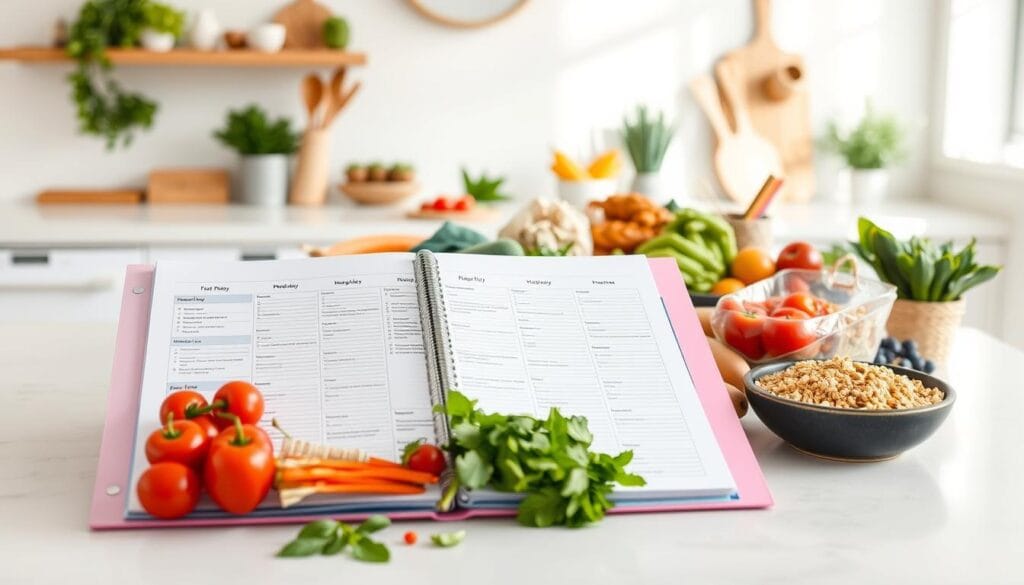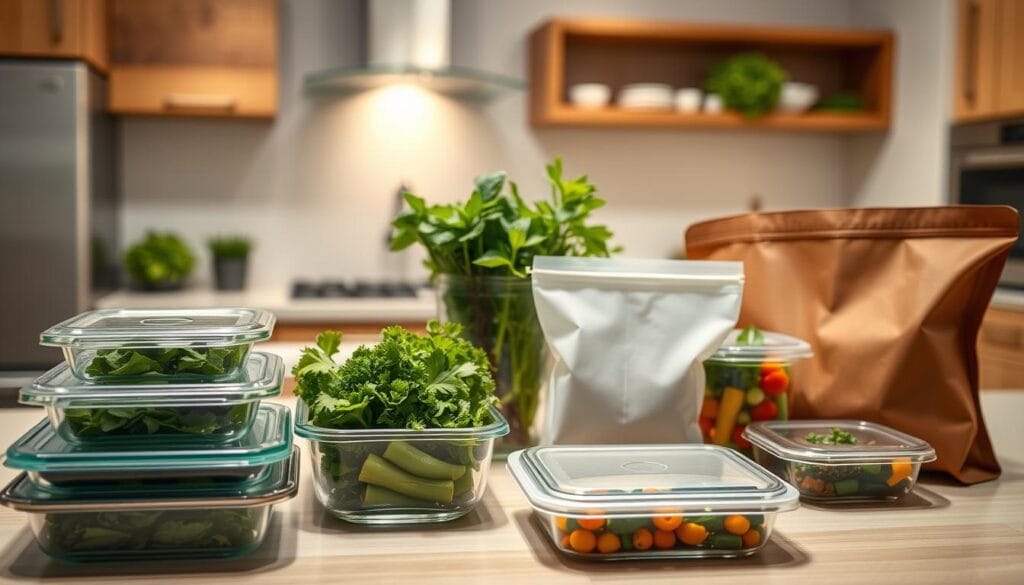Imagine it’s 5 PM, and your fridge is empty. You’re tired and hungry. What if you could start your week with meals that are good for you, save time, and taste great—all without meat? That’s what plant-based meal prep offers.
Most of us don’t get enough fiber, and we often need more calories to stay healthy. This guide turns those facts into tasty solutions. Say goodbye to last-minute takeout. Instead, enjoy balanced meals like zucchini soup or black bean chili that fit your busy schedule.
Table of Contents
Why Meatless Meal Prep Makes Sense for Your Health and Budget
Choosing meatless meal prep is more than just a change. It’s a smart move for your wallet, health, and the planet. Let’s explore the benefits.
Environmental Benefits of Reducing Meat Consumption
Less meat means less harm to our planet. Livestock farming takes up a lot of water and land. By choosing meat-free meal prep, you help the environment.
- Plant-based diets use 2x less water per calorie than beef.
- Raising livestock accounts for 14.5% of global greenhouse gas emissions.
Cost Savings of Plant-Based Ingredients
Plant proteins are cheaper than meat. For example, a pound of lentils can make 12 meals for just $0.50 each. This is much less than ground beef, which costs $3.00 per pound.
| Meal Option | Cost Per Serving | Protein (g) |
|---|---|---|
| Beef Stir-Fry | $2.50 | 25g |
| Black Bean Bowl | $0.75 | 15g |
Healthy meal prep with legumes can save a family of four $18 a week.
Health Advantages of Plant-Forward Eating
Studies show meatless meal prep can lower heart disease risk by 25%. Foods like quinoa keep you full longer. A diet rich in plants is linked to:
- 15% lower BMI compared to meat-eaters.
- 30% reduced inflammation markers.
Switching to meat-free meal prep is a win-win. It’s good for your health, your wallet, and the planet.
Essential Pantry Staples for Successful Plant-Based Meal Preparation
Having a well-stocked pantry is crucial for easy plant-based meal prep. Begin with protein-rich legumes like dried lentils, chickpeas, and kidney beans. Opt for low-sodium canned beans to save time. Quinoa and whole grains like brown rice and farro are great bases for meals.
Don’t forget canned tomatoes, coconut milk, and vegetable broth for flavor. These items are key to making your meals tasty.
- Proteins: Tofu, tempeh, and textured vegetable protein (TVP) add variety. Soy curls are budget-friendly for tacos or stir-fries.
- Grains: Opt for Banza chickpea pasta or Explore Cuisine’s black bean spaghetti for hearty meals.
- Flavor boosters: Nutritional yeast (fortified with B12) and spices like turmeric (enhanced with black pepper) add depth.
- Snacks: Keep roasted edamame, pumpkin seeds, and dried fruit for quick energy.
Buying in bulk for nuts, grains, and legumes can save money. Pre-washed spinach, frozen veggies, and canned coconut milk make vegan meal prep easier. For snacks, try roasted chickpeas or almond flour-based energy balls.
Focus on versatile items like chia seeds (omega-3s) and flaxseeds (egg replacers). Store dried goods in airtight containers and rotate stock regularly. Buy seasonal produce and bulk items to stay budget-friendly.
Begin by adding one new item each week. Stock up on quick-cook grains like quinoa or couscous for fast meals. Include leafy greens like kale and collards, washing and freezing them for later. Brands like Bob’s Red Mill offer quality grains, while Trader Joe’s has affordable canned beans.
Expand your pantry gradually to support a variety of recipes without breaking the bank.
Kitchen Tools That Make Meatless Meal Prep Easier
Turn your kitchen into a plant-based powerhouse with the right tools. These tools make meal prep easier, faster, and cleaner. They help keep your meals fresh and delicious.
Time-Saving Appliances Worth the Investment
Get tools that do the hard work for you:
- High-speed blenders: Make nut butter or hummus in seconds, not minutes.
- Air fryers: Roast veggies like Brussels sprouts in 15–20 minutes, no oven needed.
- Spiralizers: Turn zucchinis into noodles in seconds, saving money.
Storage Containers and Organization Systems
Keep veggies fresh with these tips:
| Vegetable Type | Storage Method | Shelf Life |
|---|---|---|
| Leafy greens | Air-dry, store in sealed bags | 4–5 days |
| Cruciferous (broccoli, cauliflower) | Paper towel-lined containers | 7 days |
| Root vegetables | Moisture-free containers | 7 days |
| Cabbage | Wrapped in paper towels and plastic | 5 days |
| Tomatoes | Whole in mesh bags | 5–7 days |
Cutting and Prepping Tools for Efficient Vegetable Preparation
Save time with these must-haves:
- A sharp chef’s knife and a serrated knife for tough veggies like butternut squash.
- A Japanese mandoline slicer for even cuts—perfect for salads or stir-fries.
- Bamboo steamer baskets for layering veggie dishes in one pot.
Keep a trash bowl nearby for easy cleanup. Choose tools like a cast-iron skillet for even browning and nonstick surfaces.
Creating a Weekly Meatless Meal Prep Plan
Starting with a clear plan is key for vegetarian meal planning. First, check your pantry to avoid buying the same things twice. Then, pick 2-3 protein sources like lentils, tofu, or chickpeas. Add seasonal veggies and whole grains for a balanced meal.

- Batch-cook staples: Cook grains and roasted veggies in big batches. Keep them ready for quick meals.
- Designate prep zones: Set aside Sundays for chopping and cooking. Use short prep times during the week.
- Assign flexibility: Use the same roasted sweet potatoes in different dishes. It saves time and reduces waste.
Here are some meatless meal ideas:
- Tuesday: Tasty Lentil Tacos (365 cal, 19g protein) with avocado salsa
- Thursday: Grilled Bean Burgers (305 cal, 12g protein) on whole grain buns
- Saturday: Vegetarian Pad Thai (339 cal, 12g protein) with tofu
For balanced nutrition, aim for 30-35g fiber a day. Use foods like chia seeds and legumes. The American Cancer Society says these foods can lower cancer risk. Stick to 1,200 calories a day, adjusting for active family members. Don’t worry about restaurant meals sometimes—flexibility is key.
Spending 1.5-2 hours a week on meal prep is worth it. Start with 3-4 recipes and grow as you get more confident. Use apps to track your protein intake and meet your weekly goals. Choose lower-sodium canned beans to keep sodium levels down.
Complete Protein Sources to Include in Your Meat-Free Meals
Starting a meat-free meal prep plan means knowing which plant-based foods have all essential amino acids. Rice and beans or hummus with whole wheat pita are great for complete proteins without meat. This guide will show you the best sources for easy vegan meal prep.
Legumes and Beans: The Foundation of Plant-Based Proteins
Beans and lentils are packed with protein: lentils (18g/cup), black beans (15g/cup), and chickpeas (7g/1/2 cup). Canned black beans are quick to use, adding 15g protein to meals. Edamame pods (17g/cup) are great for snacks or stir-fries. Tofu (8g/3oz) can be marinated and baked in 20 minutes.
Whole Grains and Protein-Rich Alternatives
- Quinoa (8g/cup cooked) pairs well with black bean chili for a 26g protein combo.
- Amaranth (9g/cup) adds iron and magnesium to soups and salads.
- Tempeh (34g/cup) adds smoky flavor to grain bowls—try crumbling it into pasta dishes.
Nuts, Seeds, and Their Derivatives
Hemp seeds (10g/3tbsp) on salads add omega-3s. Nut butters (7g/2tbsp) boost oatmeal or sandwiches. Chia seeds (4g/2tbsp) thicken smoothies and provide calcium. Keep tahini or nutritional yeast for sauces without meat.
Plant-Based Meat Alternatives: When and How to Use Them
Tempeh (34g/cup) is good in stir-fries, while seitan (34g/½cup) mimics meat in tacos. Quorn Chik’N patties (9g/serving) are easy for weeknight meals. Pair with quinoa bowls for 26g protein per meal. Choose minimally processed options like lentil meatballs (19g/serving) for homemade dishes.
Time-Efficient Batch Cooking Techniques for Vegetarian Meals
Start your vegetarian meal planning by learning quick cooking methods. Batch cooking makes meal prep easy and fast. You can roast, slow-cook, or use multi-tasking appliances to save time. These ways don’t lose flavor or nutrition.
One-Pot Wonders for Simplified Cooking
One-pot meals like lentil curries or vegetable risottos make cleaning up easier. Just mix grains, veggies, and seasonings in one pot. Try quinoa with roasted veggies and chickpeas for a full meal. This cuts down cooking time by half and keeps meals balanced.
For example, the Cabbage Barley Soup cooks in one pot. It blends veggies and grains for 6 servings in under 30 minutes.
Sheet Pan Meals for Minimal Cleanup
Sheet pans make cooking easy and mess-free. Just toss chopped veggies, tofu, or tempeh with olive oil and spices. Roast at 425°F. Sheet-pan dinners like roasted Brussels sprouts with sweet potatoes save 30% on prep time and reduce dishes.
Use parchment paper to prevent sticking and make cleanup easier.
Slow Cooker and Instant Pot Strategies
Pressure cookers and slow cookers make bulk meals quick. Cook black bean chili or lentil soups in an Instant Pot in 20 minutes. Then, store portions for quick lunches. Slow cookers are great for overnight bean stews, ready when you get home.
Both appliances save energy and simplify recipes.
Batch cooking is key to smart vegetarian meal planning. It cuts food waste by 30% and saves $40 a month on groceries. By learning these techniques, you’ll have more time for other things. You’ll also have a base of healthy, affordable meals.
The Art of Meatless Meal Prep: Balancing Flavors and Textures
Creating meatless meal ideas that excite your taste buds is more than just swapping proteins. Flavors and textures are key to making dishes feel substantial and crave-worthy. Start by adding umami-rich ingredients like roasted mushrooms, sun-dried tomatoes, or miso paste. These add savory depth to any dish.
Herbs and spices are your secret weapons. For easy meatless meals, try these flavor combinations:
- Mediterranean: oregano, lemon zest, and sumac
- Asian: ginger, soy sauce, and toasted sesame oil
- Mexican: cumin, chili powder, and fresh cilantro
Texture is just as vital. Mix crispy roasted chickpeas with creamy avocado, or pair chewy farro with crisp cucumber slices. Adding crunch from nuts or seeds stops dishes from feeling bland or soggy. Even simple techniques like lightly toasting spices before cooking boost aroma and mouthfeel.
Storage hacks keep textures intact. Toss grains like quinoa with olive oil before roasting for a firmer bite. Store sauces separately to prevent sogginess, and add toppings like fresh herbs or toasted nuts right before serving. This keeps meals vibrant and satisfying long after prep day.
Balance fiber, healthy fats, and protein in each meal to avoid hunger pangs. Pair roasted veggies with nutty tahini dressings or creamy coconut milk. Small tweaks like this turn routine meatless meal ideas into dishes that feel hearty and nourishing. With these tips, your easy meatless meals will stand out—not just in taste but in how they keep you full and energized all day.
Storage Solutions and Shelf-Life Guidelines for Plant-Based Meals

Learning how to store your plant-based meal prep is key. It keeps your food fresh and safe. Here are some tips to help your meatless meal prep last longer:
Refrigeration Best Practices
- Keep grains, soups, and stir-fries in airtight containers at ≤40°F (4°C).
- Wrap leafy greens in damp paper towels before refrigerating to keep them crisp.
- Store herbs in oil-filled containers for 1-2 weeks.
Freezer-Friendly Vegetarian Recipes
Many dishes freeze well:
- Black bean chili: freeze in labeled portions for up to 3 months
- Vegetable lasagna: wrap tightly in foil and parchment
- Curry bases: portion into ice cube trays for quick reheating
Preventing Common Food Storage Issues
Avoid these common mistakes:
| Problem | Solution |
|---|---|
| Soggy veggies | Blanch first or use silica gel packets |
| Discolored greens | Seal in oxygen-free containers |
| Stale grains | Freeze in labeled ziplock bags |
Proper storage is crucial for your plant-based meal prep. For long-term storage, label containers with dates. Use a FIFO (first-in, first-out) system. Dried legumes last 1-2 years in sealed jars, while cooked grains last 3-4 days in the fridge. Spices lose potency after 1-2 years, so replace them often.
Quick and Satisfying Meatless Meal Prep Recipes for Beginners
Looking for meatless meal prep recipes that are simple and great for meal planning? These easy meatless meals are all about quick prep, smart storage, and big flavors. They’re perfect for anyone new to plant-based cooking or looking for tasty, easy options.
| Recipe | Prep Time | Storage Tip | Customize |
|---|---|---|---|
| Spinach-Ravioli Lasagna | 10 mins | Cover and refrigerate up to 4 days | Add sundried tomatoes or mushrooms |
| Farmer’s Market Frittata | 30 mins | Portion into containers for lunches | Swap veggies based on what’s fresh |
| Vegetable Pot Pie | 50 mins | Freeze unbaked dough for quick baking later | Use frozen peas or corn for convenience |
Begin with easy meatless meals like the 25-minute Creamy Fettuccine Alfredo (use plant-based milk instead of dairy). Or try the Black Bean Burgers made with whole wheat flour. Cook big batches of roasted veggies or marinated tofu to add to grain bowls or salads. Leftovers are great for quick dinners or lunches.
- Use frozen corn or ravioli to cut prep time
- Opt for dry beans to save money vs canned versions
- Repurpose vegetable scraps (like carrot tops) in stocks
With over 31 tested options, these meatless meal prep recipes show that plant-based cooking is easy. Try new things with what you have at home—canned tomatoes, spices, or frozen veggies. Start with a 7-day plan and adjust as needed. Your first batch of no-knead bread or cheesy mac ‘n’ cheese is waiting!
Troubleshooting Common Challenges in Plant-Based Meal Planning
Going meatless can face obstacles. This section offers solutions to keep your vegetarian meal planning on track. Whether balancing family preferences or avoiding repetitive meals, these tips adapt to your kitchen.
Handling picky eaters: Start with familiar flavors on new foods. Offer create-your-own bowls with roasted veggies, grains, and sauces. Puree cauliflower into soups or mash chickpeas into dips to sneak greens in meatless meal ideas. Gradually introduce new items weekly.
- Test recipes like zucchini noodles with marinara for pasta lovers
- Offer a “traditional” side option (e.g., grilled cheese alongside lentil stew)
Beat meal fatigue: Rotate 3 core recipes weekly. Swap ingredients in a grain bowl—try quinoa one week, farro next. Schedule “free days” to try new dishes. For motivation, track progress with a calendar or app.
Adjusting portions: Use ratios, not exact measurements. Double a chili recipe by increasing beans and tomatoes proportionally. Prep core elements like rice or lentils separately to mix into different dishes. A 4-serving curry can serve 6 with extra veggies.
Remember: Consistency, not perfection, matters most. Small changes like adding one extra veggie to meals build lasting habits. Need help? Dietitians can tailor vegetarian meal planning for your household’s needs.
Conclusion: Embracing the Meatless Meal Prep Lifestyle
Choosing a meatless meal prep lifestyle brings many benefits. It saves money, improves your health, and helps the environment. Start by adding one or two meat-free days a week. Every step you take towards eating more plants helps you and the planet.
The Nourish Method suggests eating 1½ cups of dark leafy greens and 2½ cups of different vegetables daily. Add whole grains and legumes for a balanced diet. Supplements like B12 and omega-3s can help if you’re eating only plants. Even small changes, like choosing a black bean patty instead of a burger, make a big difference over time.
Ethan J. Green’s Plant-Based Delights has 550 meatless meal ideas. These range from quick breakfasts to dinners inspired by around the world. Each recipe has tips for making it your own, making it easy for anyone to try new things. With simple steps, even beginners can make tasty dishes like quinoa bowls or lentil curries.
Studies show that cooking at home increases vegetable intake and reduces calories. Meal prep also helps reduce food waste, which is over 200 pounds per person each year. Begin by trying one new meatless recipe each week. Look for inspiration online or in cookbooks. The key is to keep moving forward, even if it’s just a little bit at a time.
Every meal is a chance to try new ingredients and take care of your body. Whether you eat only plants or just have meatless days, your choices have a big impact. Small actions today lead to a healthier, greener future, one meal at a time.

